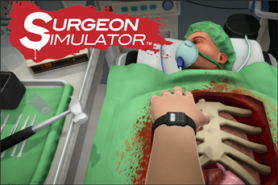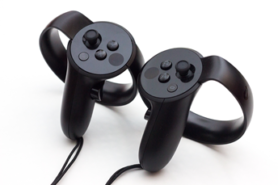21st Century Doctors
Surgeon Simulator, but better
Virtual Reality, also known as VR, is becoming increasingly popular and accessible. It is mainly known for games and interior design but is also slowly making its appearance in other fields, such as the medical sector. Maybe you have heard of Surgeon Simulator? As soon as you put on the VR goggles in Surgeon Simulator, you are in an operating room. However, the messy nature of a game makes it unsuitable for a serious simulation. Could it be made better for doctors to practice with? Fundamental Surgery and many others think so.

Figuur 1: een screenshot van Surgeon Simulator, een game die je speelt
vanuit het oogpunt van een chirurg. De game is zowel normaal als
in VR te spelen. En sinds augustus is ook een deel 2 verkrijgbaar.
If you ask people to give a definition of what they think VR is, a few keywords appear regularly, but some are also missing. From the repeated occurrence of those keywords, it can be concluded that most people know what Virtual Reality is. Half of the people who took part in a small survey mentioned VR goggles in their definition. VR goggles contain two small screens, one per eye. Putting on the goggles temporarily closes you off from the space around you, it seems as if you are really looking into another space. This is also something that came back in different words in everyone’s definition: “you are entering a fully digital world”. What was striking is that they did not mention other ways to experience a virtual reality. A flight simulation is an example of a virtual reality that is still often experienced by a computer screen. In this simulation you can see on the screen what the pilot would normally see.

Figuur 2: de Oculus Touch controllers die bij de VR-brillen van Oculus horen.
Bron: Wikipedia
Various people and companies currently work on VR simulations, which do provide a realistic picture of various surgeries. Examples of companies that do this include Fundamental Surgery and Acadicus. Fundamental Surgery has two branches in their production. 1) An @Home simulation, to be used with the Oculus Rift and Oculus Touch controllers. And 2) a HapticVR simulation for on location, with a specially developed controller. Both controllers provide tangible feedback in the form of very fast vibrations. This feedback is like that of the Wii, Xbox and PlayStation controllers.
Bournemouth University conducted research in 2018 into simulating keyhole surgery with Unity. Unity normally only makes games, but it can also be used for all kinds of VR simulations. Keyhole surgery often requires tremendous precision, with a few tiny cuts, one of which is used for a small camera. The research showed that Unity is well suited for this and can speed up the creation of such a simulation.
Practicing an operation is sometimes perceived as unethical. Depending on the type of operation involved, exercises are performed on people or (sometimes deceased) animals. I have researched a preference for a physical training or a simulation. Opinions were equally divided on the options physical, simulation and both. They indicated about the physical training that they probably give a better feeling for the task. They doubt whether a simulation can be realistic enough. Everyone agreed that a simulation can reduce suffering, because most beginner mistakes are made in a virtual setting. There is a lot of confidence (4,6 / 5) that such simulations will be possible in the future. Not everyone is convinced that unexpected situations can occur in a simulation.
Although surgery simulations are still mainly under development in countries such as the United States and United Kingdom, there is already a simulation for psychology in the Netherlands. IJsfontein is a company that has been working on digitization for 20 years, including in healthcare. One of these projects, commissioned by eGGZ (electronic mental health care), is Lunchroom Zondag. In Lunchroom Zondag, a patient can experience everyday situations in a safe environment with his psychologist in a VR simulation.
It will not be long before Virtual Reality is a good alternative for practicing on living or deceased people and animals, also in the Netherlands. A lot of hard work is being done on simulations to support the learning process of a doctor. That amount of people is also increasing every year. Scientists and designers research different aspects of these simulations. Among other things, the precision and speed with which we can make the simulations. And although the training courses are still in their infancy, the general confidence in them is high.
Want to know more?
Check IJsfontein’s blog for other projects they have done, or are working on.
Acadicus has a short video on their simulations on YouTube.
For more technologies used in healthcare, look at the other articles on 21st Century Doctors.

